In in vivo evaluation of the anti-inflammatory and analgesic activities of compound Muniziqi granule in experimental animal models
- PMID: 26800679
- PMCID: PMC4722770
- DOI: 10.1186/s12906-016-0999-y
In in vivo evaluation of the anti-inflammatory and analgesic activities of compound Muniziqi granule in experimental animal models
Abstract
Background: Compound Muniziqi granule (MNZQ), a traditional Uighur medicinal preparation, comprises 13 species of medicinal plants. MNZQ is traditionally used for regulating body immunity, modulating inflammation and pain, detoxification, and inhibiting tumor growth. This study aims to scientifically evaluate the anti-inflammatory and analgesic activities of MNZQ, support its clinical use and further research with scientific evidence.
Methods: The analgesic activity of MNZQ was evaluated using hot plate test and acetic acid-induced abdominal writhing test. Acute inflammation was evaluated using xylene-induced ear edema and carrageenan-induced paw edema models, while chronic inflammation was evaluated using cotton pellet-induced granuloma model.
Results: MNZQ exerted analgesic activities with a significant dose-dependent increase in latency in the hot plate test. The percentage inhibition suggested that MNZQ exhibited analgesic activities in the central nervous system. Meanwhile, MNZQ at 0.8, 2.4, and 7.2 g/kg strongly inhibited the acetic acid-induced writhing response by 25.22% (p < 0.01), 44.60% (p < 0.001), and 49.41% (p < 0.001), respectively. MNZQ also exerted analgesic activities in the peripheral nervous system. Moreover, MNZQ was demonstrated a significant anti-inflammatory effect against xylene-induced edema in a dose-dependent manner. The percentage inhibition was 22.24% (p < 0.01) at the highest dosage of 7.2 g/kg. MNZQ at 1.62 and 4.86 g/kg significantly reduced carrageenan-induced rat hind paw edema by 82.43% and 84.32% (p < 0.001), respectively, 1 h after injecting carrageenan, and the inhibitory effect lasted for 5 h. MNZQ also exerted a significant anti-inflammatory effect against cotton pellet-induced granuloma formation. MNZQ at 1.62 and 4.86 g/kg could inhibit granuloma formation by 17.07% and 17.60%, respectively, whereas the percentage inhibition of diclofenac was 33.12%.
Conclusions: The results obtained suggest that MNZQ possesses potential anti-inflammatory and analgesic activities. This study provides a scientific basis for the use of MNZQ in alleviating pain and treating inflammatory disorders.
Figures


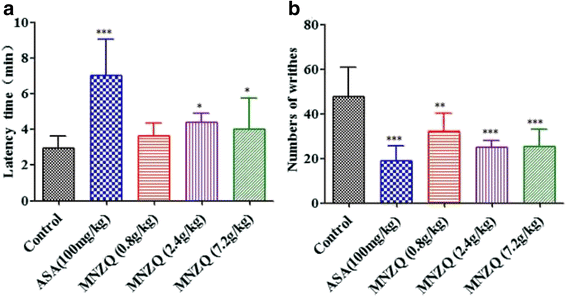
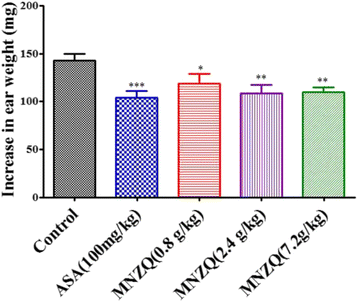
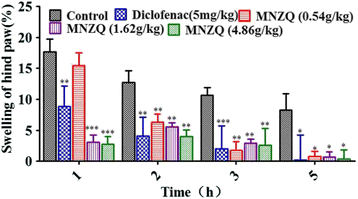
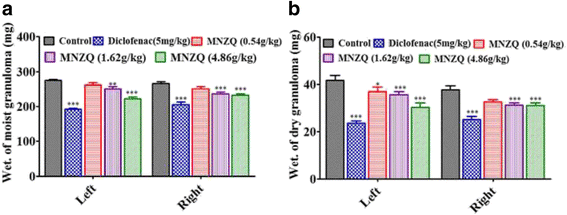
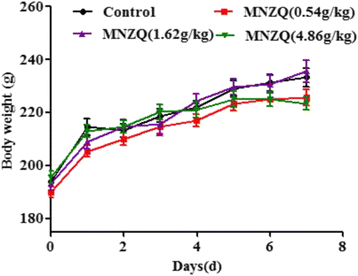
Similar articles
-
Anti-inflammatory and analgesic effects of ethanol and aqueous extracts of Pterocephalus hookeri (C.B. Clarke) Höeck.J Ethnopharmacol. 2009 Jun 25;123(3):510-4. doi: 10.1016/j.jep.2009.01.039. Epub 2009 Mar 25. J Ethnopharmacol. 2009. PMID: 19443147
-
Anti-inflammatory and analgesic effects of Bi-yuan-ling granules.J Huazhong Univ Sci Technolog Med Sci. 2016 Jun;36(3):456-462. doi: 10.1007/s11596-016-1608-5. Epub 2016 Jul 5. J Huazhong Univ Sci Technolog Med Sci. 2016. PMID: 27376820
-
Anti-inflammatory and analgesic activity of aqueous extract of Flos populi.J Ethnopharmacol. 2014 Mar 28;152(3):540-5. doi: 10.1016/j.jep.2014.01.037. Epub 2014 Feb 7. J Ethnopharmacol. 2014. PMID: 24508857
-
Anti-inflammatory, analgesic, antitussive and antipyretic activities of polyphenol-enriched fraction from Nymphaea candida.J Ethnopharmacol. 2024 Apr 24;324:117789. doi: 10.1016/j.jep.2024.117789. Epub 2024 Jan 23. J Ethnopharmacol. 2024. PMID: 38266950
-
Pharmacological evaluation of Alstonia scholaris: anti-inflammatory and analgesic effects.J Ethnopharmacol. 2010 May 27;129(2):174-81. doi: 10.1016/j.jep.2010.02.011. Epub 2010 Feb 26. J Ethnopharmacol. 2010. PMID: 20219658
Cited by
-
Curcumin's Metabolites, Tetrahydrocurcumin and Octahydrocurcumin, Possess Superior Anti-inflammatory Effects in vivo Through Suppression of TAK1-NF-κB Pathway.Front Pharmacol. 2018 Oct 17;9:1181. doi: 10.3389/fphar.2018.01181. eCollection 2018. Front Pharmacol. 2018. PMID: 30386242 Free PMC article.
-
Investigation of Wound Healing and Anti-Inflammatory Activities of Leaf Gel of Aloe trigonantha L.C. Leach in Rats.J Inflamm Res. 2021 Oct 28;14:5567-5580. doi: 10.2147/JIR.S339289. eCollection 2021. J Inflamm Res. 2021. PMID: 34737605 Free PMC article.
-
Iridoid glycosides from Morinda officinalis How. exert anti-inflammatory and anti-arthritic effects through inactivating MAPK and NF-κB signaling pathways.BMC Complement Med Ther. 2020 Jun 5;20(1):172. doi: 10.1186/s12906-020-02895-7. BMC Complement Med Ther. 2020. PMID: 32503513 Free PMC article.
-
Assessing a "Least-Concern" Red List Tree Species from Madagascar Used in Traditional Medicine: Morella spathulata (Myricaceae) Phyto-Compounds and Anti-Inflammatory Properties.Plants (Basel). 2024 Oct 17;13(20):2899. doi: 10.3390/plants13202899. Plants (Basel). 2024. PMID: 39458846 Free PMC article.
-
Patchoulene Epoxide Isolated from Patchouli Oil Suppresses Acute Inflammation through Inhibition of NF-κB and Downregulation of COX-2/iNOS.Mediators Inflamm. 2017;2017:1089028. doi: 10.1155/2017/1089028. Epub 2017 Jul 25. Mediators Inflamm. 2017. PMID: 28811678 Free PMC article.
References
-
- Wallace JL, Vong L. NSAID-induced gastrointestinal damage and the design of GI-sparing NSAIDs. Curr Opin Invest Dr. 2008;9(11):1151–6. - PubMed
-
- Burke A, Smyth E, Fitzgerald GA. Analgesic-antipyretic agents: pharmacotherapy of gout. In: Brunton LL, Lazo JS, Parker KL, editors. Goodman and Gilmans the pharmacological basis of therapeutics. New York: McGraw Hill; 2006.
Publication types
MeSH terms
Substances
LinkOut - more resources
Full Text Sources
Other Literature Sources
Medical

